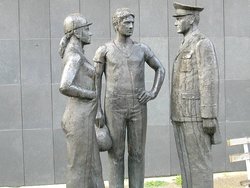Stasi
|
|
This article is about Stasi, the secret police of East Germany. See Commission Stasi for its other common meaning.
Stasiflag.PNG
The Ministerium für Staatssicherheit (German for Ministry for State Security), commonly known by the abbreviation Stasi, was the main security (secret police) and intelligence organization of the German Democratic Republic (East Germany). The Stasi was headquartered in the capital, East Berlin, with an extensive complex in Lichtenberg and several smaller complexes throughout the city. The Stasi was widely regarded as one of the most effective intelligence agencies in the world.
| Contents |
History
The Stasi was founded on February 8, 1950. It was modeled on the Soviet MGB, and was regarded by them as an extremely loyal and effective partner among the other such agencies of the Warsaw Pact.
Many early Stasi officers were former officers of the Nazi SS with East German Communist leaders actively seeking former Gestapo and SD personnel to lead the Stasi in its formative years.
Wilhelm Zaisser was its first leader, and Erich Mielke his deputy. Zaisser was removed by Walter Ulbricht in 1953 and replaced by Ernst Wollweber. Wollweber resigned in 1957 after numerous clashes with Walter Ulbricht and Erich Honecker and was succeeded by his deputy, Erich Mielke.
Also in 1957, Markus Wolf became head of the Hauptverwaltung Aufklärung (HVA) or Main Administration Reconnaissance, its foreign intelligence section.
In 1989, just before the dissolution of East Germany, the Stasi was renamed to the Office for National Security.
Influence
The Stasi's influence over almost every aspect of life in the German Democratic Republic cannot be overestimated. Until the mid-1980s, a civilian network of informants (Inoffizielle Mitarbeiter (IMs), or unofficial employee) grew within both Germanies, East and West. By the East German collapse in 1989, it is estimated that the Stasi had 91,000 full time employees and 300,000 informants. This means approximately one in fifty East Germans collaborated with the Stasi, one of, possibly THE, highest penetration of any society by an organization.
Berlin_Stasi_Normannenstrasse_2005.jpg
The Stasi monitored politically "incorrect" behavior among all citizens of East Germany, comparable to activity of the former Gestapo. During the 1989 peaceful revolution, the Stasi offices were overrun by enraged citizens, but not before a huge amount of compromising material was destroyed by Stasi officers. The remaining files are available for review to all people who were reported upon, often revealing that friends, colleagues, husbands, wives, and other family members were regularly filing reports with the Stasi. The interesting files with the names of east german foreign spies were captured by american intelligence agencies ("The Rosenholz Files").
After German unification, it was revealed that the Stasi also secretly aided left-wing terrorist groups such as the Red Army Faction. Loss of support from the Stasi was a major factor in the dissolution of these groups.
Notable People
Informants
- Ibrahim Böhme
- Günter Guillaume (who spied upon Willy Brandt, the West German Chancellor)
- Manfred Stolpe
- Christa Wolf
- Martin Kirchner
- Robin Pearson
- Vic Allen
- Wolfgang Schnur
See Also
External links
German
- More about Stasi victims (http://www.stasiopfer.de)
- Office administering the Stasi files (http://www.bstu.de)
English
- A Soviet Debriefing on the Stasi (http://www.sovietski.com/Star/stasi.html)
- The Creation and Description of a Museum about the Stasi (http://www.runde-ecke-leipzig.de/html_eng/inh_mus_run01.htm)
- Photos of Stasi Headquarters in Berlin (http://www.geocities.com/isanders_2000/stasi.htm)
- Read about the Defection of a Stasi Agent (http://www.myspystory.com/)
bg:ЩАЗИ de:Ministerium für Staatssicherheit it:Stasi nl:Stasi pl:Stasi fi:Stasi sv:Stasi

